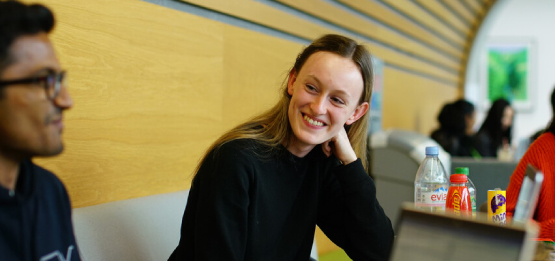Core modules
In the first year you take essential (core) modules in both mathematics and physics.
In the second and third years, there is considerable freedom to choose modules. By then you will have a good idea of your main interests and be well placed to decide which areas of mathematics and physics to study in greater depth.
Year One
Mathematical Analysis 1/2
Mathematical Analysis is the rigorous study of calculus. In this module, there will be a considerable emphasis throughout on the need to lay out mathematical arguments with much greater precision and care than you had to at school. With the support of your fellow students, lecturers, and other helpers, you will be encouraged to move on from the situation where the teacher shows you how to, say, differentiate and integrate a function, to the point where you can develop your own rigorous proofs of calculus results that you may have taken for granted. The module will allow you to deal carefully with limits and infinite summations, approximations to pi and e, and the Taylor series. The module ends with the construction of the integral and the Fundamental Theorem of Calculus.
Read more about these modules, including the methods of teaching and assessment (content applies to 2024/25 year of study):
Sets and Numbers
Mathematics can be described as the science of logical deduction - if we assume such and such as given, what can we deduce with absolute certainty? Consequently, mathematics has a very high standard of truth - the only way to establish a mathematical claim is to give a complete, rigorous proof. Sets and Numbers aims to show students what can be achieved through abstract mathematical reasoning.
Read more about the Sets and Numbers moduleLink opens in a new window, including the methods of teaching and assessment (content applies to 2024/25 year of study).
Linear Algebra
The branch of maths treating simultaneous linear equations is called linear algebra. The module contains a theoretical algebraic core, whose main idea is that of a vector space and of a linear map from one vector space to another. It discusses the concepts of a basis in a vector space, the dimension of a vector space, the image and kernel of a linear map, the rank and nullity of a linear map, and the representation of a linear map by means of a matrix. These theoretical ideas have many applications, which will be discussed in the module. These applications include: Solutions of simultaneous linear equations. Properties of vectors. Properties of matrices, such as rank, row reduction, eigenvalues and eigenvectors. Properties of determinants and ways of calculating them.
Read more about the Linear Algebra moduleLink opens in a new window, including the methods of teaching and assessment (content applies to 2024/25 year of study).
Mathematical Methods and Modelling 1 and 2
Introduces the fundamentals of mathematical modelling, before discussing and analysing difference and differential equations in physics, chemistry, engineering as well as the life and social sciences. This will require the basic theory of ordinary differential equations (ODEs), the cornerstone of all applied mathematics. ODE theory later proves invaluable in branches of pure mathematics, such as geometry and topology. You will be introduced to simple differential and difference equations, methods for obtaining their solutions and numerical approximation.
In the second term for Mathematical Methods and Modelling 2, you will study the differential geometry of curves, calculus of functions of several variables, multi-dimensional integrals, calculus of vector functions of several variables (divergence and circulation), and their uses in line and surface integrals.
Read more about these modules, including the methods of teaching and assessment (content applies to 2024/25 year of study):
Physics Foundations
You will learn about dimensional analysis, thermodynamics and waves. Often the qualitative features of systems can be understood (at least partially) by thinking about which quantities in a problem are allowed to depend on each other on dimensional grounds. Thermodynamics is the study of heat flow and how it can lead to useful work. Even though the results are universal, the simplest way to introduce this topic is via the ideal gas, whose properties are discussed and derived in some detail. Finally, waves are time-dependent variations about some time-independent (often equilibrium) state. You will look at phenomena like the Doppler effect (this is the effect that the frequency of a wave changes as a function of the relative velocity of the source and observer), the reflection and transmission of waves at boundaries and some elementary ideas about diffraction and interference patterns.
Read more about the Physics Foundations moduleLink opens in a new window, including the methods of teaching and assessment (content applies to 2024/25 year of study).
Electricity and Magnetism
This module is largely concerned with the great developments in electricity and magnetism, which took place during the nineteenth century. The origins and properties of electric and magnetic fields in free space, and in materials, are tested in some detail and all the basic levels up to, but not including, Maxwell's equations are considered. In addition, the module deals with both dc and ac circuit theory including the use of complex impedance. You will be introduced to the properties of electrostatic and magnetic fields, and their interaction with dielectrics, conductors and magnetic materials.
Read more about the Electricity and Magnetism moduleLink opens in a new window, including the methods of teaching and assessment (content applies to 2024/25 year of study).
Classical Mechanics and Special Relativity
You will study Newtonian mechanics emphasising the conservation laws inherent in the theory. These have a wider domain of applicability than classical mechanics (for example they also apply in quantum mechanics). You will also look at the classical mechanics of oscillations and of rotating bodies. The module then explains why the failure to find the ether was such an important experimental result and how Einstein constructed his theory of special relativity. You will cover some of the consequences of the theory for classical mechanics and some of the predictions it makes, including: the relation between mass and energy, length-contraction, time-dilation and the twin paradox.
Read more about the Classical Mechanics and Special Relativity moduleLink opens in a new window, including the methods of teaching and assessment (content applies to 2024/25 year of study).
Quantum Phenomena
This module explains how classical physics is unable to explain the properties of light, electrons and atoms. (Theories in physics that make no reference to quantum theory are usually called classical theories.) It covers the most important contributions to the development of quantum physics including: wave-particle 'duality', de Broglie's relation and the Schrodinger equation. It also looks at applications of quantum theory to describe elementary particles including their classification by symmetry, how this allows us to interpret simple reactions between particles and how elementary particles interact with matter.
Read more about the Quantum Phenomena moduleLink opens in a new window, including the methods of teaching and assessment (content applies to 2024/25 year of study).
Physics Programming Workshop
This module introduces the Python programming language. It is quick to learn and encourages good programming style. Python is an interpreted language, which makes it flexible and easy to share. It allows easy interfacing with modules that have been compiled from faster C or Fortran code. It is widely used throughout physics and there are many downloadable, free-to-use codes available. The module also looks at the visualisation of data.
Read more about the Physics Programming Workshop moduleLink opens in a new window, including the methods of teaching and assessment (content applies to 2024/25 year of study).
Year Two
Analysis 3
This module lays the basis for many subsequent mathematically-inclined modules, and it is concerned with further study of the notions of convergence and calculus seen in Analysis 1 and 2. Creating a consistent theoretical framework for these concepts has kept many great mathematicians busy for many centuries, and in this module you walk in their footsteps.
Read more about the Analysis 3 moduleLink opens in a new window, including the methods of teaching and assessment (content applies to 2024/25 year of study).
Methods of Mathematical Physics
The module covers the theory of Fourier transforms and the Dirac delta function. The module also introduces Lagrange multipliers, co-ordinate transformations and cartesian tensors illustrating them with examples of their use in physics. Fourier transforms are used to represent functions on the whole real line using linear combinations of sines and cosines. A Fourier transform will turn a linear differential equation with constant coefficients into a nice algebraic equation which is in general easier to solve. The module explains why diffraction patterns in the far-field limit are the Fourier transforms of the "diffracting" object. The case of a repeated pattern of motifs illustrates beautifully one of the most important theorems in the business - the convolution theorem. The diffraction pattern is the product of the Fourier transform of repeated delta functions and the Fourier transform for a single copy of the motif.
Read more about the Methods of Mathematical Physics moduleLink opens in a new window, including the methods of teaching and assessment (content applies to 2024/25 year of study).
Partial Differential Equations
The theory of partial differential equations (PDE) is important in both pure and applied mathematics. Since the pioneering work on surfaces and manifolds by Gauss and Riemann, PDEs have been at the centre of much of mathematics. PDEs are also used to describe many phenomena from the natural sciences (such as fluid flow and electromagnetism) and social sciences (such as financial markets). In this module you will learn how to classify the most important partial differential equations into three types: elliptic, parabolic, and hyperbolic. You will study the role of boundary conditions and look at various methods for solving PDEs.
Read more about the Partial Differential Equations moduleLink opens in a new window, including the methods of teaching and assessment (content applies to 2024/25 year of study).
Hamiltonian and Fluid Mechanics
This module looks at the Hamiltonian and Lagrangian formulation of classical mechanics and introduces the mechanics of fluids. Lagrangian and Hamiltonian mechanics have provided the natural framework for several important developments in theoretical physics including quantum mechanics. The field of fluids is one of the richest and most easily appreciated in physics. Tidal waves, cloud formation and the weather generally are some of the more spectacular phenomena encountered in fluids. The module establishes the basic equations of motion for a fluid - the Navier-Stokes equations - and shows that in many cases they can yield simple and intuitively appealing explanations of fluid flows.
Read more about the Hamiltonian and Fluid Mechanics moduleLink opens in a new window, including the methods of teaching and assessment (content applies to 2024/25 year of study).
Quantum Mechanics and its Applications
In the first part of this module you will use ideas, introduced in the first year module, to explore atomic structure. This includes the time-independent and the time-dependent Schrödinger equations for spherically symmetric and harmonic potentials, angular momentum and hydrogenic atoms. The second half of the module looks at many-particle systems and aspects of the Standard Model of particle physics. It introduces the quantum mechanics of free fermions and discusses how it accounts for the conductivity and heat capacity of metals and the state of electrons in white dwarf stars.
Read more about the Quantum Mechanics and its Applications moduleLink opens in a new window, including the methods of teaching and assessment (content applies to 2024/25 year of study).
Statistical Mechanics, Electromagnetic Theory and Optics
Any macroscopic object we meet contains a large number of particles, each of which moves according to the laws of mechanics (which can be classical or quantum). Yet we can often ignore the details of this microscopic motion and use a few average quantities such as temperature and pressure to describe and predict the behaviour of the object. Why we can do this, when we can do this and how to do it are discussed in the first half of this module.
We also develop the ideas of first year electricity and magnetism into Maxwell's theory of electromagnetism. Establishing a complete theory of electromagnetism has proved to be one of the greatest achievements of physics. It was the principal motivation for Einstein to develop special relativity, it has served as the model for subsequent theories of the forces of nature and it has been the basis for all of electronics and optics (radios, telephones, computers, the lot...).
Read more about the Statistical Mechanics, Electromagnetic Theory and Optics moduleLink opens in a new window, including the methods of teaching and assessment (content applies to 2024/25 year of study).
Year Three
Communicating Science
Employers look for many things in would-be employees. Sometimes they will be looking for specific knowledge, but often they will be more interested in general skills, frequently referred to as transferable skills. One such transferable skill is the ability to communicate effectively, both orally and in writing. Over the past two years you may have had experience in writing for an academic audience in the form of your laboratory reports. The aim of this module is to introduce you to the different approaches required to write for other audiences. This module will provide you with experience in presenting technical material in different formats to a variety of audiences.
Read more about the Communicating Science moduleLink opens in a new window, including the methods of teaching and assessment (content applies to 2024/25 year of study).
Optional modules
Optional modules can vary from year to year. Example optional modules may include:
- Measure Theory
- Topics in Mathematical Biology
- Complex Analysis
- Fluid Dynamics
- Theory of PDEs
- Physics Project
- Quantum Physics of Atoms
- Electrodynamics
- Kinetic Theory
- Condensed Matter Physics
- Scientific Computing
- The Earth and its Atmosphere
- Plasma Physics and Fusion
- The Standard Model
- Galaxies and Cosmology
- Statistical Physics
- Physics of Life and Medicine
- Black Holes, White Dwarfs and Neutron Stars






















